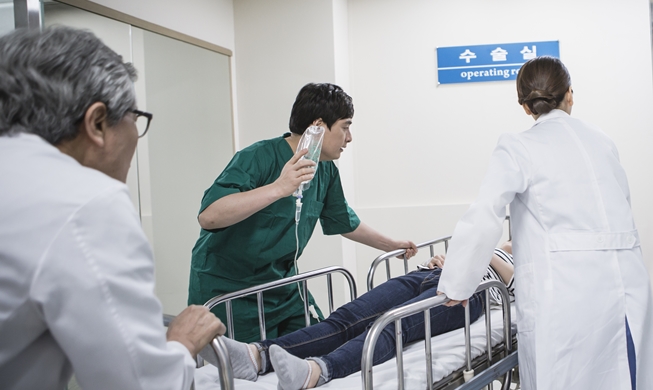He is the executive director of the Purme Foundation, Paik Kyung-hak. He has put all his wealth and all his heart into making the world a happier and easier place for people with disabilities, both physical and mental. Paik established the foundation in 2005 with the aim of giving the disabled the best treatment possible and also of helping them to stand on their own two feet.
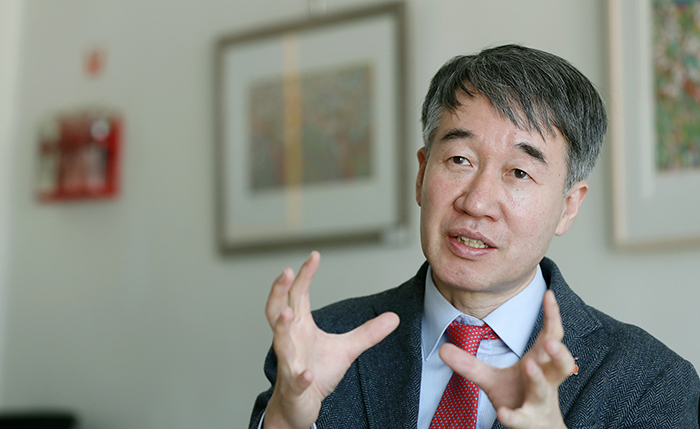
Executive Director Paik Kyung-hak of the Purme Foundation stresses that, ‘It’s our duty to help the disabled get proper treatment from early on, and also help them to land a job as a full member of society.’
The foundation’s building is located in the Seochon neighborhood, meaning “West Village,” in Jongno-gu District, northern Seoul. With its office on the fourth floor, the foundation operates a dentist’s office on the first floor, a clinic on the second, and a welfare center on the third. Surprisingly, the facilities were set up with funds donated to the foundation.
“About 3,000 supporters of our foundation came and made donations, which amounted to over KRW 8.5 billion,” said Paik. “Thanks to all those who trusted our foundation and the goals we pursued, we could build this great building,” he said, thanking all those who chipped in for the cause.
In March last year, the foundation opened another hospital, the Purme Foundation Nexon Children’s Rehabilitation Hospital, in Mapo-gu District, Sangam-dong. This hospital treats not only outpatients, but also inpatients. More than 500 patients a day receive treatment here, he said.
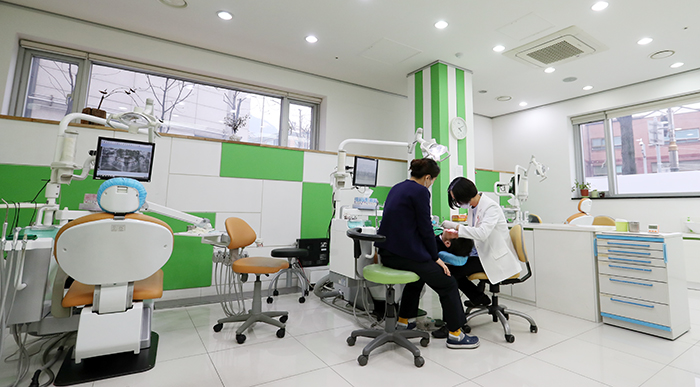
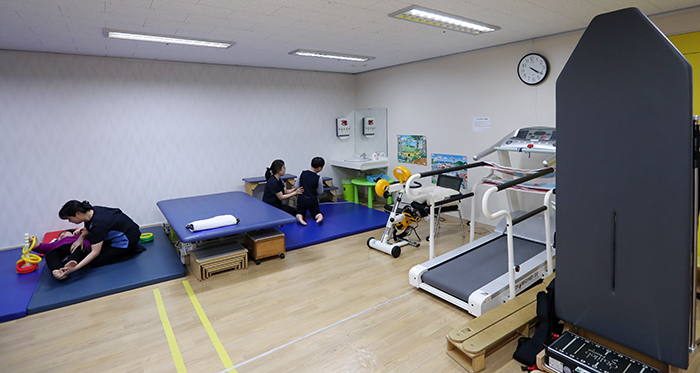
Children with disabilities receive treatment at the dentist’s office (top) and at a physiotherapy clinic run by the Purme Foundation.
“I dreamed of building a hospital where children with disabilities could get intensive care, and the dream came true 11 years after I launched the Purme Foundation,” said the philanthropist.
Paik’s original profession was as a journalist. He worked for such domestic dailies as CBS, the Hankyoreh and the Donga Ilbo.
A car accident involving him and his family turned his life upside down, however. While traveling, his wife and he were hit by an out-of-control driver. She suffered a severe injury from the waist down and has been confined to a wheelchair for the rest of her life. He then founded the Purme Foundation and has been heading it for more than 12 years. His dream is to make the world a better place for his beloved wife and other people like her.
- We’ve known that it’s your wife that has made you change from being a full-fledged journalist to starting the Purme Foundation.
In 1996, I had a chance to study at the institute of political science at Munich University in Germany. I studied inter-Korean unification and studied how we could apply Germany’s experiences with its east-west unification to the still divided Korean Peninsula. In June 1998, after two years of training there, my family and I decided to take a road trip across Britain before going back to Korea. During that trip, we suffered a life-changing car accident. A driver under the influence rammed into the back of our car as we were pulled over at the roadside, just as my wife was taking something out of the trunk. My wife stayed in a coma for 100 days. She had to be treated in the ICU for more than 3 months. I then realized what a useful and efficient national health service Britain had. After treatment in Britain, we moved to Germany, where my wife received special treatment for more than one and a half years. I got to know how that country ran a great healthcare system, too. I witnessed, in a very painful way, how both countries put patients, especially in critical condition, under special care.
German doctors advised me that my wife should continue to receive treatment even when she was back in Korea, as patients who suffered disabilities caused by an accident like she did would have their bones and muscles slowly start to stiffen without continuous treatment.
We came back to Seoul, expecting that it’d be not too difficult to get my wife hospitalized for treatment. The reality, however, was completely different. At that time, there were only two rehabilitation hospitals in Seoul that my wife desperately needed and, also, the one and only option we had was a single room at one of the hospitals. I realized how our healthcare system was falling behind, even more after I experienced the advanced systems in Britain and Germany. I felt angry about the way in which Korea didn’t have any such hospitals like I had seen in Britain and Germany. I was determined to build such hospitals designed for the disabled by myself, here at home. That’s how it all got started.
- Rehabilitation clinics and hospitals run by the Purme Foundation were both established solely by means of donations and crowdfunding. In today’s world, perhaps somewhat hard-hearted and tight-fisted, raising such an amount could be very difficult.
You need assets before you can establish any form of foundation. I mean, you basically need wealth to start. I started with KRW 1.6 billion from a total of KRW 2.6 billion we got in damages after eight years of a bitter lawsuit in Britain. After quitting my long-time job as a journalist, I opened a restaurant named “October Fest” in an effort to make some seed money. Fortunately, the business went well and I was able to scrape up more by selling a 10 percent stake in the business.
Since it started operations, the foundation has been engaged in a number of fund-raising activities, like hosting marathons for the disabled and art and photography exhibitions. In 2007, the dentist’s office opened as part of the foundation. Since then, the number of donors has continued to grow, to a point where we could raise as much as KRW 43 billion. With those donations, the foundation opened another hospital on a larger scale, the Purme Foundation Nexon Children’s Rehabilitation Hospital, in Mapo-gu District, Sangam-dong, in 2016.
- What have been some of the difficulties you've had running the Purme Foundation?
It was tough when I planned to set up the hospital. I had many people asking, “Shouldn't the nation and the government come forward first to establish such facilities for the disabled? Why should it be your foundation and why us?” I had to get around them first and it was tough. I tried to talk them into believing, “It’s a common issue in which we all have to get involved, helping the disabled to get the treatment they need and helping them to fit into the world as part of society.”
Running a hospital for the disabled is a business that loses money. Treating those with disabilities takes more time than ordinary patients and the number of disabled patients who can receive treatment per day can be very limited. In comparison, operating expenses, including labor costs, cost a lot more. That’s why I say it's a losing business. For this reason, universities and other organizations avoid running a hospital specialized in the disabled. Otherwise, the government would have to establish such hospitals. However, it’s not willing to invest in such ill-fated businesses. I’ve never seen a single hospital set up over the past decade. Well-off patients can afford expensive treatment at university hospitals, but those in need can’t afford it and have to give up on treatment. That’s the reality we face. The absence of early treatment makes them become more of a burden to their family for the rest of their lives. Half of disabled children have seen their family fall apart as their parents get divorced. Apart from being misfortune to an individual, this problem can be a social and economic waste to the nation.
The Purme Foundation has become sort of a role model in this regard, as it has created hospitals to provide better treatment for them, when the government stays back. We proved that we citizens can make this happen by ourselves. It’s our obligation to make a difference to the lives of disabled people.
- Do you think any changes have been made in the lives of the disabled since your foundation began?
Yes. I’ve witnessed changes in the public perception toward people with disabilities, changes in rehabilitation facilities and changes in their lives overall.
My wife now walks on a prosthetic leg, her left leg. One day, my wife travelled on a wheelchair to her daughter’s primary school where all the kids stared at her, whispering, “She doesn’t have a leg!” I had friends of my daughter's over every year and allowed them to touch and feel my wife’s artificial leg. I then explained how a horrible accident had happened to her and said that friends and families around them, too, could become physically disabled in such sudden, unexpected accidents. I just wanted to send a message that those with disabilities, too, should be treated in the same way as we want others to treat ourselves.
Public perceptions of the disabled has changed, as well. People are more considerate of those with both physical and intellectual disabilities. More buildings are free of door sills that can be an obstacle to physically disabled visitors.
It’s gotten much easier for the disabled to get a job, like a telephone customer service representative, too. We're now living in a world where those with autism, intellectual and developmental disabilities, go out and find a job. The world is getting better. Cafés that my foundation has opened have a total of 15 autistic young people working there. Their mothers often say, “It’s okay that my child doesn’t get paid. All I ask is to keep my child working. That would be a blessing by itself.” Things are changing, slowly but surely.
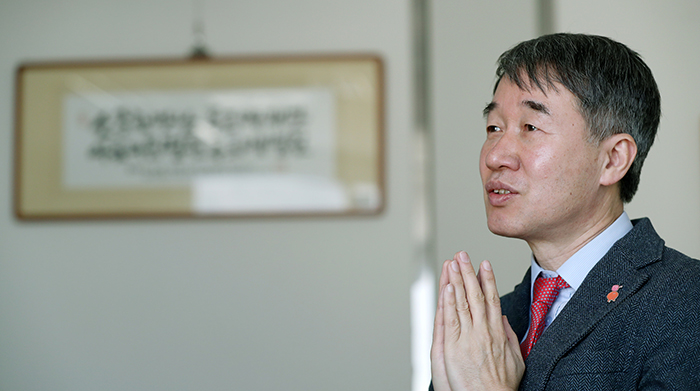
Executive Director Paik Kyung-hak of the Purme Foundation says, ‘To make any difference to the lives of the disabled, we must work together and be part of the effort to make that happen.’
- If there are things that you think should be changed to make the world an even better place for the disabled, what would they be?
I think that medical insurance benefits for individuals with severe disabilities must double. It’s a problem that those in need receive the same amount of benefits as ordinary people. You must know that it takes two or three times as much time to treat such disabled patients, as well as it can be really tough to handle them during treatment. That’s why most clinics and hospitals are reluctant to accept disabled patients. I don’t expect hospitals to become willing to accept them in the future. A new kind of legal mechanism that protects the disabled should be put in place. That move requires the government and political decisions. In addition, rehabilitation hospitals should be available across the nation so that the disabled don't need to travel as far as Seoul all the time to get treatment.
I hope that my foundation will have more regular donors. We currently have about 7,000 sponsors, either individuals or groups, who make donations on a regular basis. Hopefully, that number will double to reach the 15,000 mark. Only when we work together, will we be able to make the foundation and its offspring hospitals keep working for those in need.
- When was it that you found it rewarding to run this foundation? Have you ever felt that doing this job is the best decision you've ever made?
There was a 5-year-old child whom we just called “Min.” When he couldn’t stand up or sit down, even at the age of 2, his mother took him to our hospital and he has since received treatment. One day, I got a call from his mother who cried and said, “My son started walking eventually!”
Right after I hung up, I cried, “Our Min is walking!” All the staff clapped and cried in celebration. It’s a moving sight to see. Although not every child under treatment at our hospitals will be able to see a miracle, it’s always encouraging to see many young patients of ours get healthier and go back to their school and family, and even get a job.
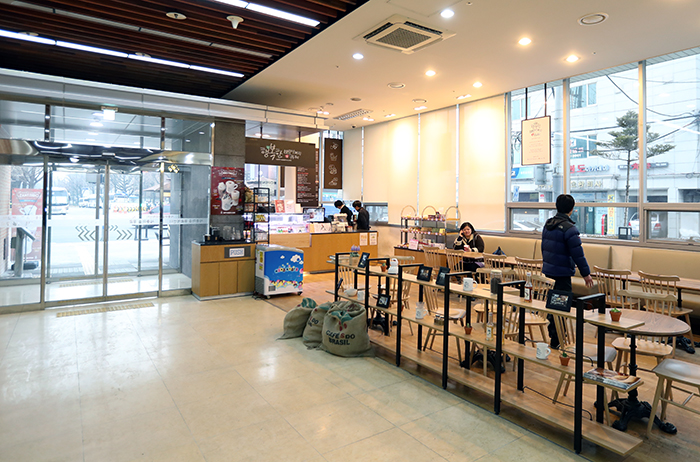
The Purme Foundation runs five cafés where autistic youth serve coffee, bread and other beverages. Pictured is the café on the first floor of the foundation’s four-story building in Jongno-gu District, northern Seoul.
- Your foundation has engaged in many other projects, besides running hospitals. What are they?
We have two welfare centers and the Aizone, where children with severe autism can get treatment, as well as sport and cultural centers, a vocational training center, and five cafés where autistic youth work together with their non-autistic peers. We also have an orchestra made up of the intellectually disabled. It’s our duty to help them to think about how they can contribute to society in some way and to do it right when they finally go out into the world.
- Tell us your next plans.
We plan to open two more cafés that will lead to more jobs for those with disabilities. We will continue to work to create workplaces for them in an effort to help them survive in this challenging world.
Around 30 to 40 percent of our young patients travel from the countryside. While they're treated, they're forced to be separated from the rest of their family. They're only able to see their mother, father or siblings just once per month. If there’s at least one hospital near their homes, however, they wouldn’t need to be apart from their family and wouldn’t need to move as far as Seoul at a huge expense.
I’ve insisted that there should be at least one hospital specializing in disabled patients in each region across the nation. That’s the nation’s responsibility. Only if local government heads and the central government work together, would it be possible to make that happen. What’s no less important is to help disabled children become independent individuals who stand on their own feet, not a burden to their family. To this end, there should be jobs available for them. We give a significant amount of thought to how we can create jobs for these members of our society.
Our foundation will continue to strive to help create a rehabilitation hospital in each region of the country, as well as create more jobs that the disabled, especially children and youth, like to do and do well.
By Sohn JiAe
Korea.net Staff Writer
Photos: Jeon Han Korea.net Photographer
jiae5853@korea.kr
Most popular
- 2 Egyptian sisters reflect on 10 years as Honorary Reporters
- Korea Welcome Week for foreign tourists set from April 25-May 16
- Korea.net welcomes 2025 K-influencers, Honorary Reporters
- Actor Bae Doona's first romcom in decade to hit theaters in May
- 2025 Honorary Reporter class pledges to spread 'real Korea' worldwide
